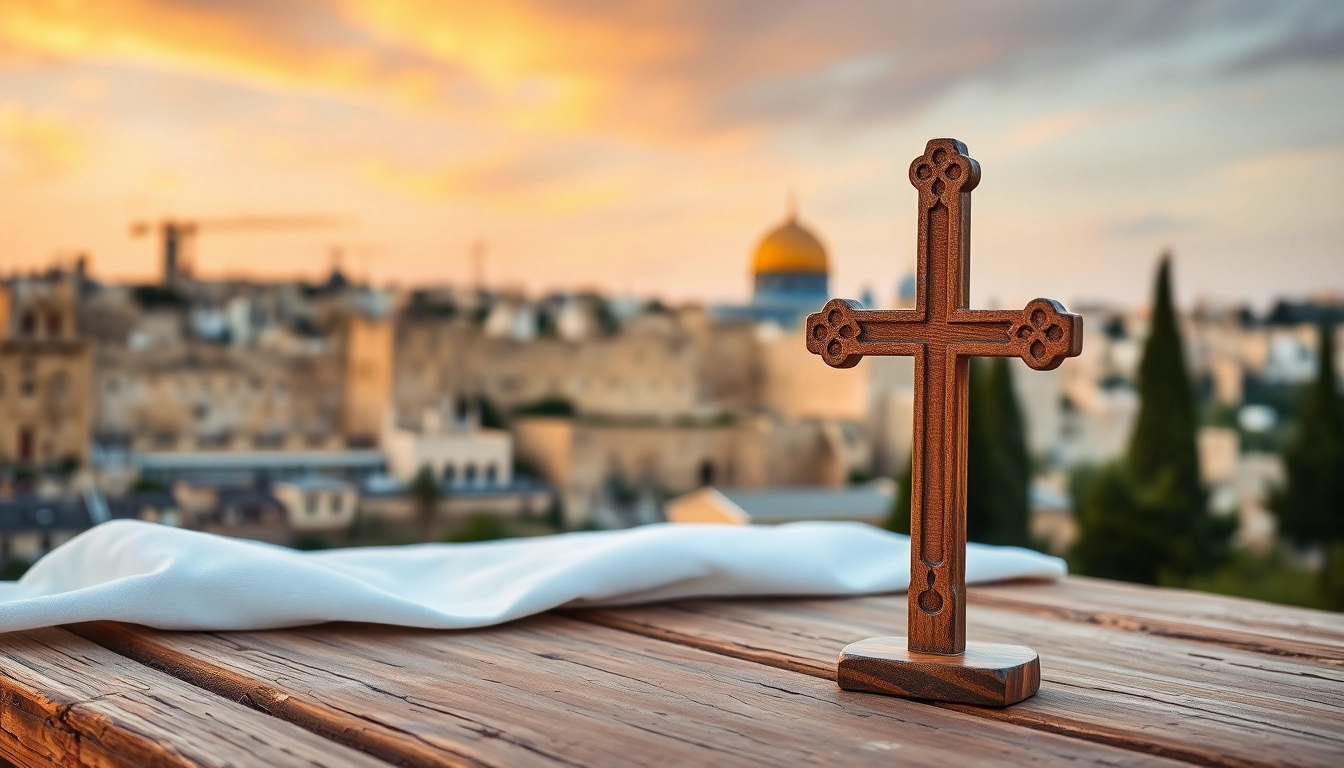The Jerusalem crosses hold a significant place within Christian symbolism and are celebrated for their rich historical, cultural, and spiritual significance. These unique exemplars of craftsmanship not only represent religious beliefs but also embody a convergence of artistic expression and theological concepts. In this comprehensive exploration, we will delve into the various dimensions of Jerusalem crosses, including their symbolism, historical context, cultural interpretations, artistic representations, role in religious practices, ways to incorporate them into personal spaces, and their preservation for future generations.
Understanding the Symbolism of Jerusalem Crosses
The Five Points and Their Meaning
The Jerusalem cross, also known as the “five-fold cross,” is characterized by its large central cross potent with four smaller Greek crosses positioned in each quadrant. This design is rich in symbolism, representing various aspects of the Christian faith. The large central cross is often viewed as a symbol of Christ’s sacrifice, while the four smaller crosses signify the Four Evangelists—Matthew, Mark, Luke, and John. This arrangement highlights the spread of the Gospel message originating from Jerusalem to the four corners of the earth.
Furthermore, the number five holds deep significance in Christianity. It symbolizes God’s grace, and the five wounds of Christ, connecting the believer’s readiness to receive and share the divine message. The use of the Jerusalem cross serves as a powerful reminder for Christians to embody their faith and spread compassion and understanding worldwide.
Historical Context of Jerusalem Crosses
The roots of the Jerusalem cross trace back to the early Christian era, gaining prominence during the Crusader Kingdom of Jerusalem in the 11th century. Initially adopted by the Crusaders, the cross became emblematic of their efforts to reclaim Jerusalem and the Holy Land. Its use was not merely as a religious symbol but also as a battle standard that represented the aspirations of those seeking to secure Christian dominion in the region.
Throughout history, the Jerusalem cross has drawn upon the rich tapestry of Christian history, reflecting the complexities of faith, conflict, and cultural exchange. It has been featured prominently in various ecclesiastical heraldry and remains an enduring symbol within both Catholic and Orthodox traditions. As Christianity evolved, so too did the interpretation and usage of the Jerusalem cross, solidifying its place as a cherished emblem among believers.
Cultural Interpretations and Variations
Different cultures have embraced the Jerusalem cross and adapted it into their local traditions and artistic expressions. In Eastern Christian art, the Jerusalem cross is often depicted in a more ornate fashion, showcasing intricate details that reflect regional artistry. Customarily carved from local materials, these adaptations underscore the importance of context and locality in religious symbolism.
Moreover, various communities integrate the Jerusalem cross into their festivals and ceremonies, each infusing their own cultural identity into the representation of the cross. By examining these variations, one can appreciate how a singular emblem can transcend geographical barriers and resonate with diverse audiences—unifying believers under a shared symbol of hope and resurrection.
The Artistic Representation of Jerusalem Crosses
Common Materials and Craftsmanship Techniques
The creation of Jerusalem crosses often involves artisanal craftsmanship, drawing on traditional methods that emphasize the use of high-quality materials. Common materials include olive wood, silver, and gold, each contributing to the distinctive character of the cross. Olive wood, in particular, is prized for its association with the Holy Land, carrying a tactile connection to Jesus’ life and ministry.
Traditional techniques such as engraving, carving, and inlay work are frequently employed to enhance the visual appeal of the Jerusalem cross, transforming each piece into a unique work of art. Artisans often combine these materials with various decorative elements, including gemstones and intricate patterns, to create stunning representations that hold both spiritual and aesthetic value.
Notable Artists and Their Works
Throughout history, many artists have employed the Jerusalem cross in their works, bringing forth new interpretations and artistic expressions that reflect the evolving nature of Christian art. Prominent artwork can be found within the expansive architectural designs of religious structures, offering physical manifestations of faith for future generations to experience.
For instance, contemporary artists continue to explore the symbolism of the Jerusalem cross in varied forms, including paintings, sculptures, and jewelry. This ongoing dialogue of faith and creativity exemplifies how tradition and modernity coexist and enrich the artistic landscape surrounding this historic symbol.
Modern Art Inspired by Jerusalem Crosses
In recent years, contemporary interpretations of the Jerusalem cross have emerged, reflecting the dynamic nature of religious expression in modern art. Artists leverage new media and innovative techniques to create pieces that resonate with today’s audiences while maintaining the core symbolism of the cross. This evolution underscores the timeless relevance of the Jerusalem cross, conveying messages of peace, hope, and love that transcend cultural and temporal boundaries.
Moreover, exhibitions featuring modern renderings of the Jerusalem cross allow viewers to engage with this emblem through a fresh lens, prompting deeper contemplations on faith and its place within contemporary society.
The Role of Jerusalem Crosses in Religious Practices
Usage in Christian Traditions
In many Christian traditions, the Jerusalem cross serves as a vital symbol within religious practices. It is often incorporated into liturgical settings, used in ceremonies such as baptisms, confirmations, and weddings. Its presence reinforces the spiritual significance of these rites of passage, reminding participants of their connection to the universal Church and the legacy of Christ.
The Jerusalem cross is also used in educational contexts, where it functions as a teaching tool to convey Christian principles and stories. As such, its role transcends mere symbolism, becoming an integral part of the communal and individual faith experience.
Symbolism in Ceremonies and Sacraments
The symbolism of the Jerusalem cross extends deeply into various ceremonies and sacraments within Christianity. During baptisms, for example, the cross is often displayed prominently, serving as a visual reminder of the infant’s entry into the Christian faith. In the context of Holy Communion, the cross symbolizes the communion shared with Christ and the sacrifice He made for humanity.
Moreover, in memorial services, the Jerusalem cross is frequently remembered for its associations with hope and redemption. By incorporating this emblem, believers are reminded of Christ’s promise of resurrection and the eternal life that faith offers. This duality of grief and hope encapsulated within the cross serves as a comfort for many during times of loss.
Influence on Contemporary Faith Expressions
As modern expressions of faith continue to evolve, the Jerusalem cross remains vital in bridging traditional spiritual practices with contemporary spirituality. Many believers wear the Jerusalem cross as a necklace or tattoo, using it as a personal testament of faith that reflects their spiritual journey. This trend not only highlights individual expressions of belief but also serves as a conversation starter about the deeper message behind the emblem.
Furthermore, contemporary worship settings increasingly incorporate artistic representations of the Jerusalem cross, merging music, visual art, and spoken word to create a holistic spiritual experience. These modern approaches resonate with diverse audiences, fostering a sense of community and shared understanding among believers from various backgrounds.
How to Incorporate Jerusalem Crosses into Personal Spaces
Decorative Ideas for Homes and Churches
Integrating Jerusalem crosses into personal spaces can significantly enhance the spiritual ambiance of a home or church. Various decorative ideas encompass everything from wall hangings to subtle centerpiece elements that leverage the cross’s symbolism. For example, a prominent display of Jerusalem crosses in a dedicated prayer corner can serve as a focal point, inviting reflection and meditation.
In church settings, altar decorations featuring Jerusalem crosses emphasize their role in the liturgy and invite congregants to participate in the communal aspect of faith. Outdoor gardens can also utilize the Jerusalem cross in landscaping, creating paths that inspire careful contemplation and spiritual connection to nature.
Symbolic Gifts and Their Meaning
Offering Jerusalem crosses as gifts can convey deep significance and thoughtfulness. They serve as symbols of faith, love, and hope, making them ideal gifts for occasions such as weddings, confirmations, and religious milestones like the birth of a child. Personalized touches like inscriptions or custom designs on these crosses further amplify their meaningfulness, making them cherished heirlooms for future generations.
In gift shops and online platforms, Jerusalem crosses are often available in various sizes, materials, and designs. Whether they are presented as jewelry or decorative art pieces, these gifts carry lasting messages that resonate with the recipients and strengthen their relationship with their faith.
Ways to Educate Others About Their Significance
Education holds the key to understanding and appreciation of the Jerusalem cross’s significance. Hosting workshops, informational sessions, or discussion groups within communities can promote awareness about the cross’s history, symbolism, and cultural importance. Through storytelling and personal narratives, participants can explore the myriad meanings attached to the Jerusalem cross and its relevance in their lives.
Leveraging social media platforms and online forums can also facilitate education about the Jerusalem cross. By sharing insights, artworks, and discussions, users can spread knowledge and foster meaningful connections surrounding this powerful symbol of faith.
Preserving the Cultural Heritage of Jerusalem Crosses
Importance of Artisanal Craftsmanship
The artisanal craftsmanship behind Jerusalem crosses is vital for maintaining the legacy of this cherished symbol. Traditional methods of carving, engraving, and assembly require skilled artisans who carry on the techniques passed down through generations. Each crafted piece tells a story—not just of the craftsmanship itself, but of the faith and dedication embedded in every stroke of the tool.
Supporting artisans in the production of Jerusalem crosses not only preserves traditional craftsmanship but also contributes to the socioeconomic development of local communities. By elevating their work within the cultural heritage framework, we ensure that these artisans can continue to share their knowledge and skills with future generations.
Supporting Local Artisans and Communities
Beyond individual purchases, actively promoting local artisans and their crafts can help sustain the market for Jerusalem crosses. Initiatives such as local art fairs, online marketplaces, and exhibitions can showcase their talent, enabling communities to appreciate the artistry while ensuring the survival of traditional methods.
Encouraging conversations about the artisanship can enhance recognition and value for their work. Engaging consumers in discussions about where their crosses originate fosters a deeper connection to the cultural significance behind the objects they decorate their lives with.
Future of Jerusalem Crosses in Art and Culture
The future of Jerusalem crosses lies in their ability to adapt and resonate within contemporary art and culture. As artistic expressions diversify, there is a profound opportunity for innovative interpretations of the cross to emerge, inviting broader audiences to engage with its rich history and symbolism.
Additionally, collaborations between artists, theologians, and cultural historians can lead to new projects that explore the intersection of faith and art. Such collaborations may yield exhibitions, publications, and events that celebrate the Jerusalem cross, ensuring its relevance continues far into the future.



